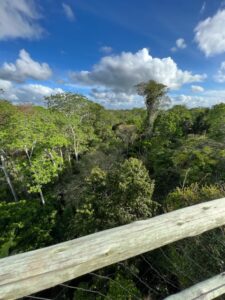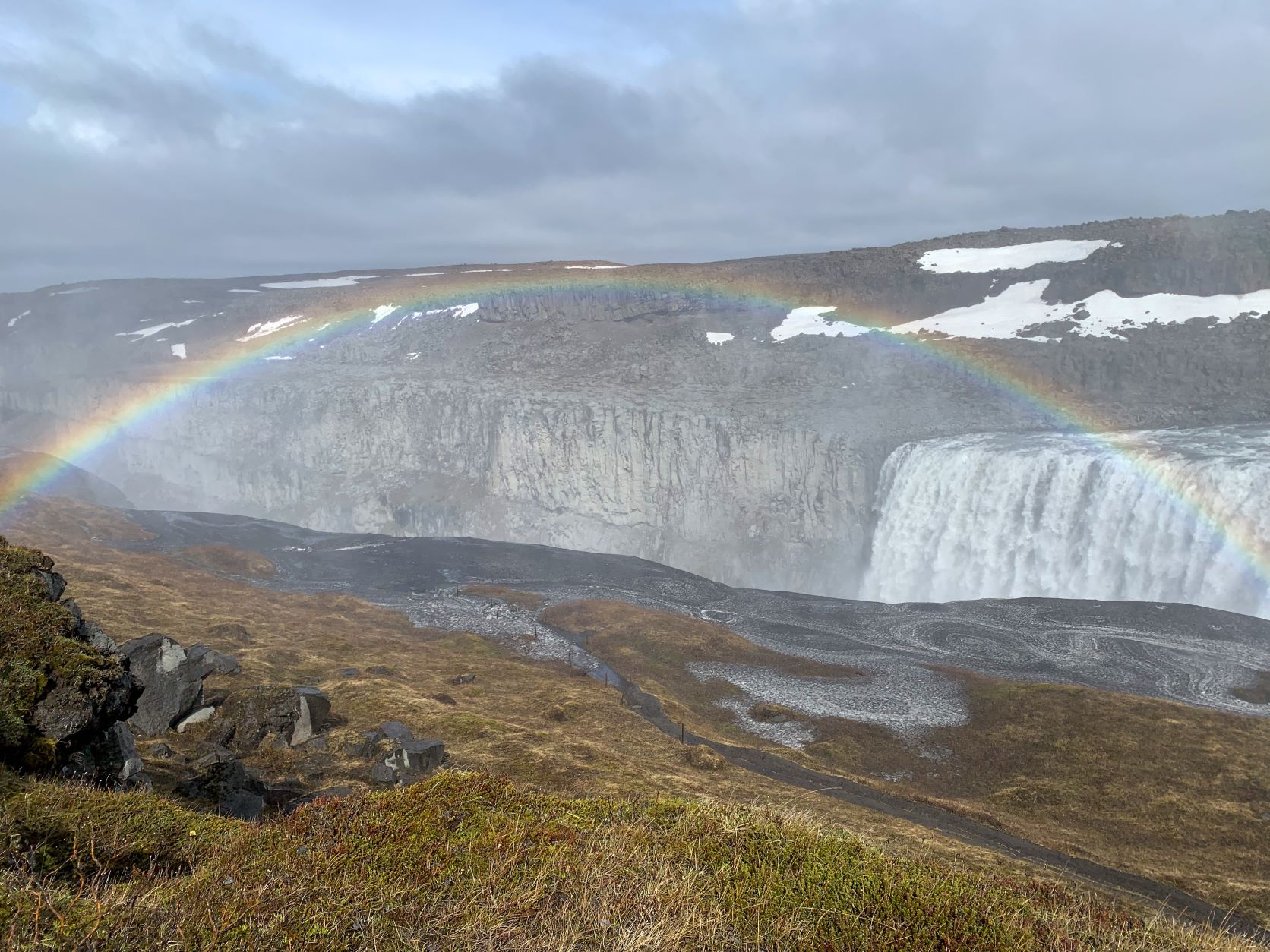
May 22-29, 2022
Susan Campbell and Steve Shultz, leaders
Narrative by Steve Shultz, Photos by Steve Shultz and Gretchen Locy
Sunday, May 22 – Keflavik
We land in an unusually sunny and not as windy as one might expect Keflavik International Airport. Our carriage onto the island is Icelandair’s “Latrabjarg.” Apropos as these are Iceland’s grandest bird breeding cliffs, and we are on a birding trip! A good omen we hope. We pick up our van and head to nearby Konvin Hotel. As our group is arriving on different flights, this hotel will allow for some relaxation before it is time for our first local foray.
By early afternoon we are ready bird around the western end of the Reykjanes Peninsula. We make our way to the lighthouse-tipped point of land west of the village of Gardur, braving wind, warm but nonetheless strong, to scope waters amazingly blue. We spot the standard assortment of eiders, shorebirds, and even a few far away Manx Shearwaters. We continue to the ponds along the road through Keflavik, which provide more viewing opportunities for local waterfowl, Common Redshank, Eurasian Golden-Plover (which stand around in grassy yards as well), Eurasian Oystercatchers (these prefer to stand in parking lots) and gulls.
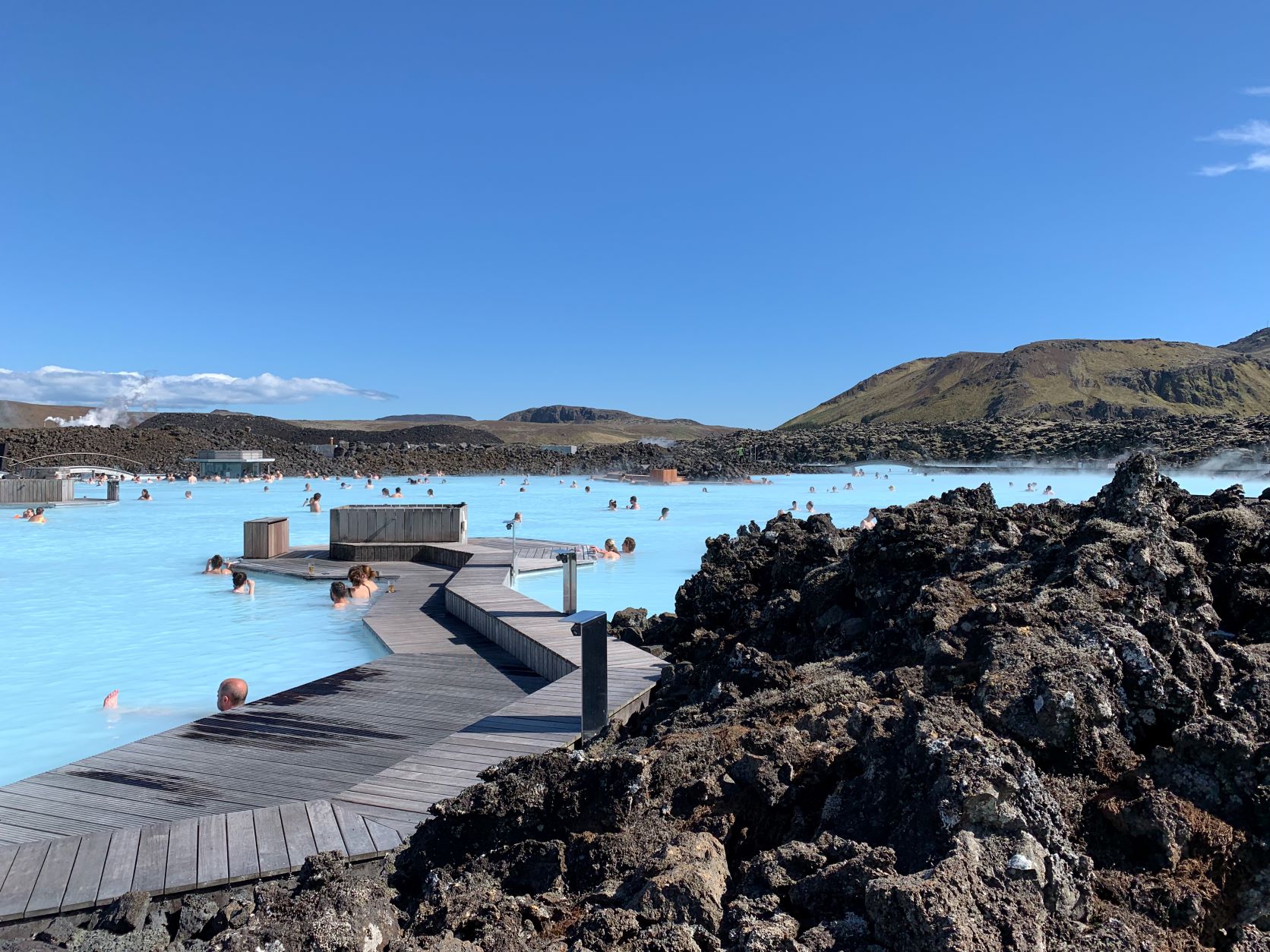
After dropping off two of our participants at the Blue Lagoon for a soak, we repair to the “bunny park”, our name for the little copse of woods along a hillside near a lake (that never has any birds) named Seltjörn. No bunnies this time, but there is a Common Redpoll showing quite nicely on the ground near the parking lot. Another swing past the ponds at Keflavik and a quick retracing of our steps brings us back to Blue Lagoon. Along one of the trails where folks not bathing can enjoy the ultra-blue water, a seemingly out of place eider is loafing in the azure pool. Next it is a short journey to Anton’s Mamma Mia. The proprietor, Gudmundur Falk, is an avid birder and photographer who recently opened the restaurant in downtown Keflavik. We have the chance not only to see our friend “Gumi” again, but he asks if we would mind if he and a birder friend sit with us. What a treat! Birding stories fill the time before food arrives, and everyone raves.
Monday, May 23 – Kelfavik to Vik
We drive through Grindavik, lamenting that none of the recent string of earthquakes has resulted in another eruption, then follow the coast road past the site of last year’s volcano. Our immediate destination is the bird nesting area known as Krísuvíkurberg Cliffs.
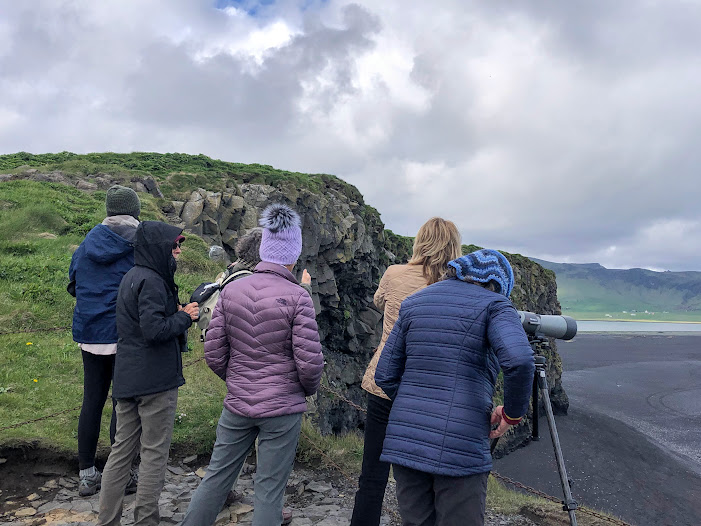
We arrive to thousands of birds swirling around, coming and going to nests on cliffs 150 feet high. The majority of these are fulmars and Black-legged Kittiwakes, but alcids including Common Murre, Razorbill, and Atlantic Puffin are present as well.

With a warning to keep clear of the edge, which apparently is a bit crumbly, we enjoy swirls of kittiwakes, many carrying vegetation with which to nest, gathered from nearby meadows, and rafts of alcids in the almost tropically blue water. We get a very nice look at a breeding plumaged Shag as it paddles by. This is the first chance that many of the folks have to see nesting seabirds here in Iceland. We spend about a half hour at the cliffs before bumping back along the dirt path to pavement and then making the short drive to Seltun. Here we give the participants twenty minutes to wander the boardwalk through bubbling hot springs, paint pot and boiling mud.
We follow route 427 to the intersection with 34, crossing the mouth of Ölfusá River’s bay, where we begin to see waterfowl and shorebirds. By 2:30 we’ve reached the famous walk-behind waterfall Seljalandsfoss.
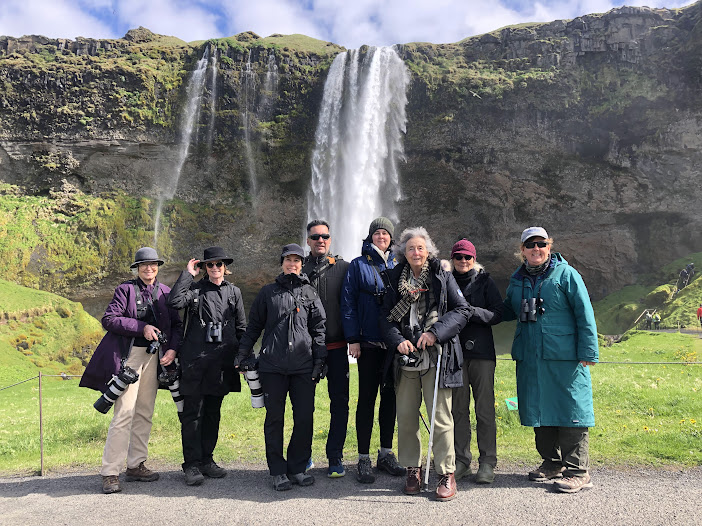
Tumbling over a former coastline during times of higher sea levels, the 200-foot falls always provides for a scenic stop. Today’s sunshine, blue sky, and “waterbows” formed in the mist make this one of our most scenic visits to this favorite waterfall. Next stop: Skogafoss!
A short ride west along the Ring Road brings us to the pull-off for Skógafoss (translates to ‘Forest Falls’), one of Iceland’s most photographed waterfalls, and even more impressive on a sunny day like today. This waterfall is situated on the Skógá River in the south of Iceland at the cliffs of the former coastline. After the coastline had receded seaward, the former sea cliffs remained, parallel to the coast over hundreds of kilometers, creating together with some mountains a clear border between the coastal lowlands and the Highlands of Iceland. The Skógafoss is one of the biggest waterfalls in the country with a width of 82 feet and a drop of 200 ft. Nesting Northern Fulmars dot the ledges around the falls, as they do on so many of the cliff faces in this part of the country.
We proceed onward to the bird cliffs near Vik for the last birding spot for the day. Turning off the Ring Road, we pass through pastoral farms under steep mountain slopes as we drive to the sea at Dyrhólaey, which roughly translates as “the hill-island with the door-hole.” Here we find Common Eiders swimming in gentle backwaters or sitting on the black sand beach while scores of Murres float nearby. Looking north toward Vik reveals a grand landscape of broad beach backed by lagoons and cliffs, punctuated by a tall, black pillar of weather resistant rock. We walk over to the turf-topped cliffs that the Atlantic Puffins prefer, and within a short while spot one of the tuxedo-clad, clown-nosed birds standing outside a burrow. Over the next twenty minutes or so we show everyone in the group, as well as various passersby, the Puffins, which seem to come out of the burrows (where they are presumably incubating eggs) for one of two purposes, flying out to sea to forage, or to poop. And for the record, a Puffin can projectile poop quite impressively. It’s also a neat orange-yellow color. After soaking in scenery and pointing out rafts of Murres, we head back to the Ring Road.
A short side trip before we head to the hotel brings us to Reynisfjara Black Sand Beach, affording views of the sea pillars sticking up from the Atlantic just off Vik, but also allowing inspection of a sea cave walled in hexagonal columnar basalt columns. We even spot a few more Puffins heading to nests high on top of the cliff. Pulling into the hamlet of Vik, Iceland’s southernmost town, we head for our lodging, Hotel Vik I Myrdal.
Tuesday, May 24 – Vik to Höfn
Our destination today is the east Iceland town of Höfn, which Americans generally pronounce as Ho-fun, but is actually pronounced something more like “Hupp!” Amazingly, the sun is out again today. Before leaving town, we take a short detour to the postcard perfect church on the hill above the village.
letting folks snap photos of the neat and tidy frame building, field of lupine behind, and small but colorful town below. We head out of town and into the wilds of south-east Iceland. For the first hour or so out of Vik we drive through rather pretty lava fields, the lumpy landscape covered in green moss and purple lupine. Our next destination is Skaftafell National Park, nominally affording trail access to a super-cool waterfall and a quickly receding glacier, Redwings, Snipe and snowy peaks.
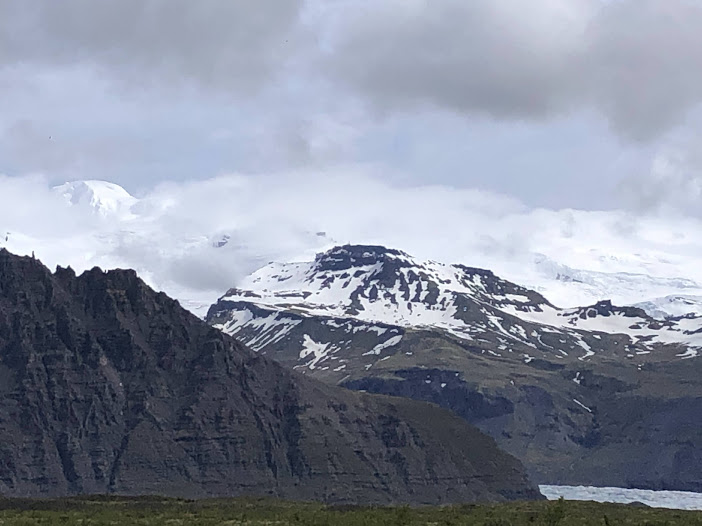
Back on the road and heading for the glacial lagoon, we come across our first Barnacle Geese. This species started breeding in Iceland not that many years ago, and can reliably be found only in this area, so a treat to see.
But even better is the sighting nearby of an Arctic Fox! The fox appeared to be trying to sneak up, unsuccessfully, on a Graylag Goose.
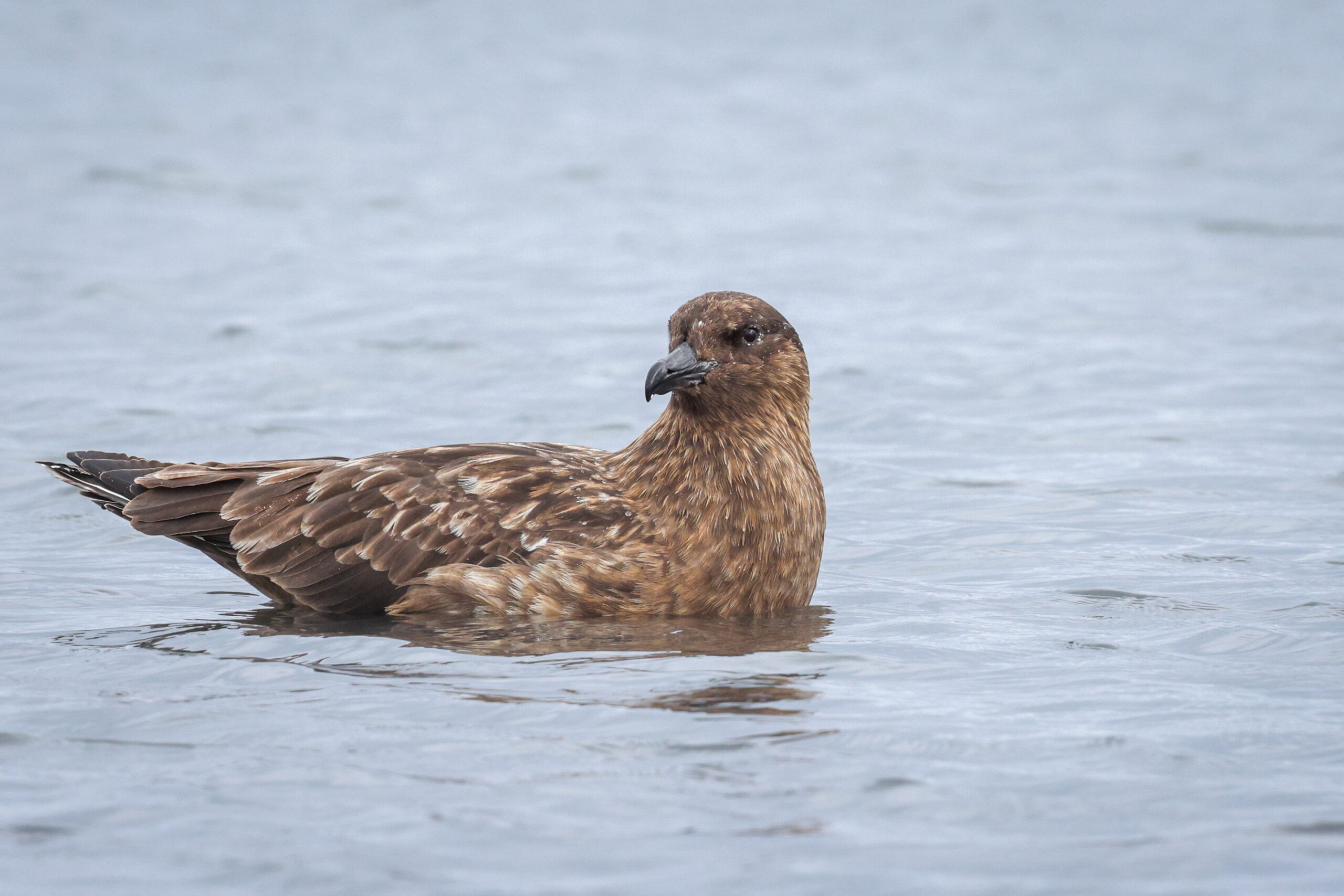
A last bit of driving brings us to “Diamond Beach” where remnants of bergs wash up on black sand. An assortment of birds swirl over the intersection of cold glacial freshwater and cold oceanic seawater, including jaegers and skuas, which we finally get decent looks of. In fact, a completely nonplussed Great Skua stakes out a small tidal pond, oblivious to the birders and photographers in our midst passing close by. Seals float in the “river”, said to be Iceland’s shortest at less than a mile.
Back in the parking lot, a snazzy Snow Bunting attracts attention. We head over to the other side of the road and the amazing site of a freshwater lake crowded with blue and white icebergs.
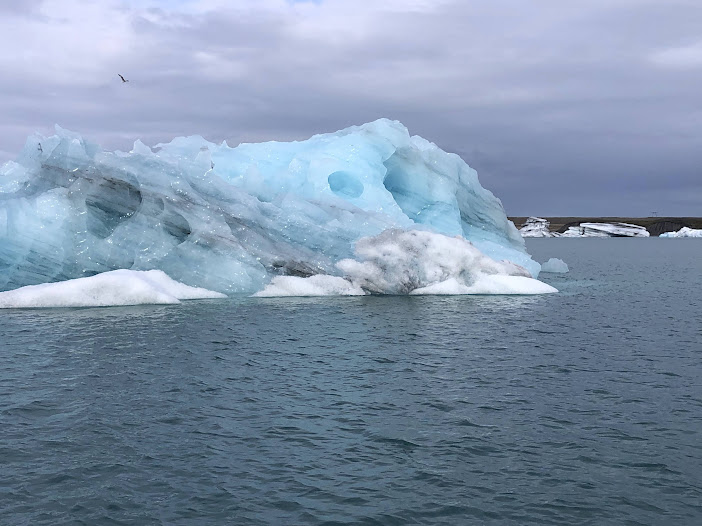
Jökulsárlón; literally “glacial river lagoon” is a large glacial lake situated at the head of the Breiðamerkurjökull glacier, it developed into a lake after the glacier started receding from the edge of the Atlantic Ocean. The lake has grown since then at varying rates because of melting of the glaciers. The lagoon itself has a lot of ice floating around. Ice here tends to congregate at the beginning of the short river, presumably due to the underwater portion of the bergs getting caught on the bottom.
When the 4:30 rolls around, we load up on “Klaki,” our amphibious craft, and head out.

We roll a hundred yards or so along a gravel path, round a small hill, then drive straight into the clear, blue water and steam for a nearby berg. We don’t get too close (they can flip over apparently, and that would be a bad thing) but experience a kaleidoscope of blues and whites as sunlight hits the bergs from various angles.
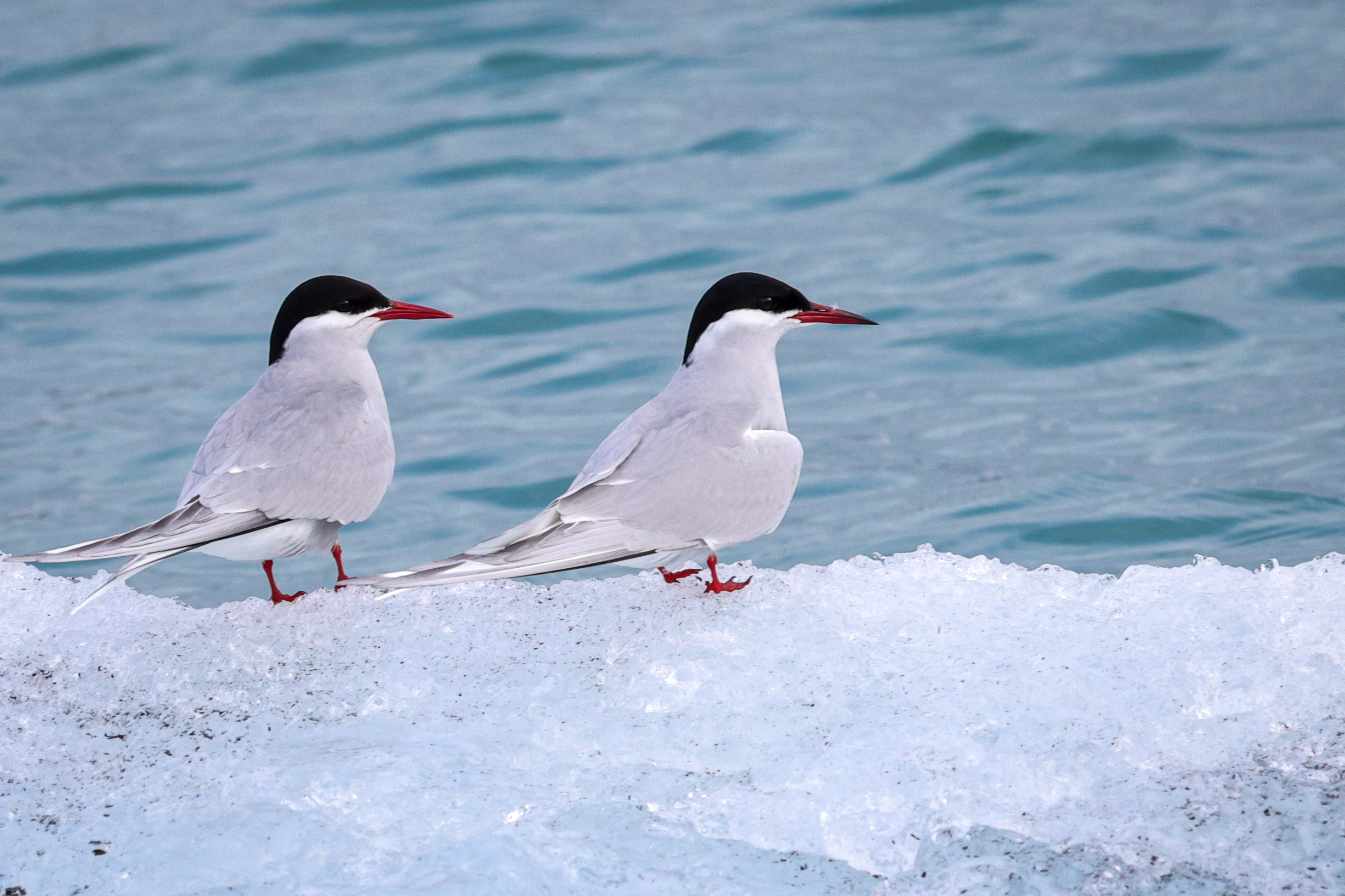
We note numerous seals and abundant bird life, including dozens of Arctic Terns and scores of gulls, the birds roosting atop the ice, the cold apparently not much of an issue.
We enjoyed a bit of a weather window at the glacial lagoon, with high overcast, but as we drive onward to Höfn, ceilings lower, and by the time we reach our lodging for the evening, Seljavellir Guesthouse, it’s raining. We find Seljavellir contemporary and comfortable and all that is needed for an overnight stay. After stowing our bags, we head to town for dinner.
Wednesday, 5/25 – Höfn to Lake Mývatn
The rain continued overnight and is forecast to stay with us much of the day. This is classic Iceland! But the rain did not keep some in the group from making a pair of nifty bird sightings, birds that both Susan and I miss: a Short-eared Owl flopping over the farmland behind the hotel and seven Common Wood-pigeons on the wires behind the hotel!
As it turns out, this is a true rarity for Iceland. Although the species has been spotted here and there in the country in the last couple years, Wood-pigeons are still unexpected—and this large a group is unheard of!! We all enjoy the motel’s breakfast spread, and then dodge raindrops to load up the van.
Today, we enter the “Eastfjords.” Accordingly, the terrain changes from a broad coastal plain backed by mountain escarpment, to a series of deeply indented fjords and associated mountain ranges. We begin to see Fulmars again, and waterfalls press close to the Ring Road versus sitting back a few miles across green pasture. The scenery is probably gorgeous on a clear day, but with ceilings of only a few hundred feet, mountaintops are obscured in gauzy white. We pass an area of extensive tidal flats, crossing a long, low causeway, before the coast becomes rocky. Just beyond Djúpivogur we soon spot Reindeer!

We come across a group grazing at the base of a cliff just off the road. Over the next hour or so we spot several groups of the cream-colored caribou creatures, including a trio that crosses the road just in front of the van. The scenery includes fjords and then significantly rockier terrain as we gain elevation. We come across our first Harlequin Ducks, although sadly there is no place to pull off. Next is first male Rock Ptarmigan near the road: sitting atop (gasp!) a rock!
The drive up and over a low mountain pass on route 95 is fun. We start in a wide, u-shaped valley that folks dub the Icelandic Shenandoah Valley, with a broad, shallow river in the center and bucolic farms alongside the road. At the valley’s head, the road begins to switchback up into snowy terrain, topping out near a lovely blue lake.
We follow a similar valley down the other side and make our way to Egilsstaðir. After a short stop we cross the Þjóðvegur Bridge. The canyon and river below look pretty scenic, and there is a pull-off and picnic area just before the river, so we loop around and park. How fortuitous: our “most wanted for the day” species, Pink-footed Goose! This species breeds in the highlands along rivers, and we were not sure how easy they would be to find. As it turns out, pretty easy! Birds fly back and forth across the river and stand around in nearby fields. We are still low enough to be passing plenty of farms and pastures. The gorge below holds the river Jökulsá á Bru: the longest river in northeast Iceland. We spot several more groups of reindeer before the landscape becomes rockier and lunar looking as we climb into the highlands. With no trees, patches of late melting snow, and gently sloping hills, this appears to be tundra. From here on, we don’t see much in the way of birds, although this should be great for Northern Wheatear.
We arrive at Dettifoss is a waterfall in Vatnajökull National Park in Northeast Iceland and is reputed to be the second most powerful waterfall in Europe (after the Rhine Falls).
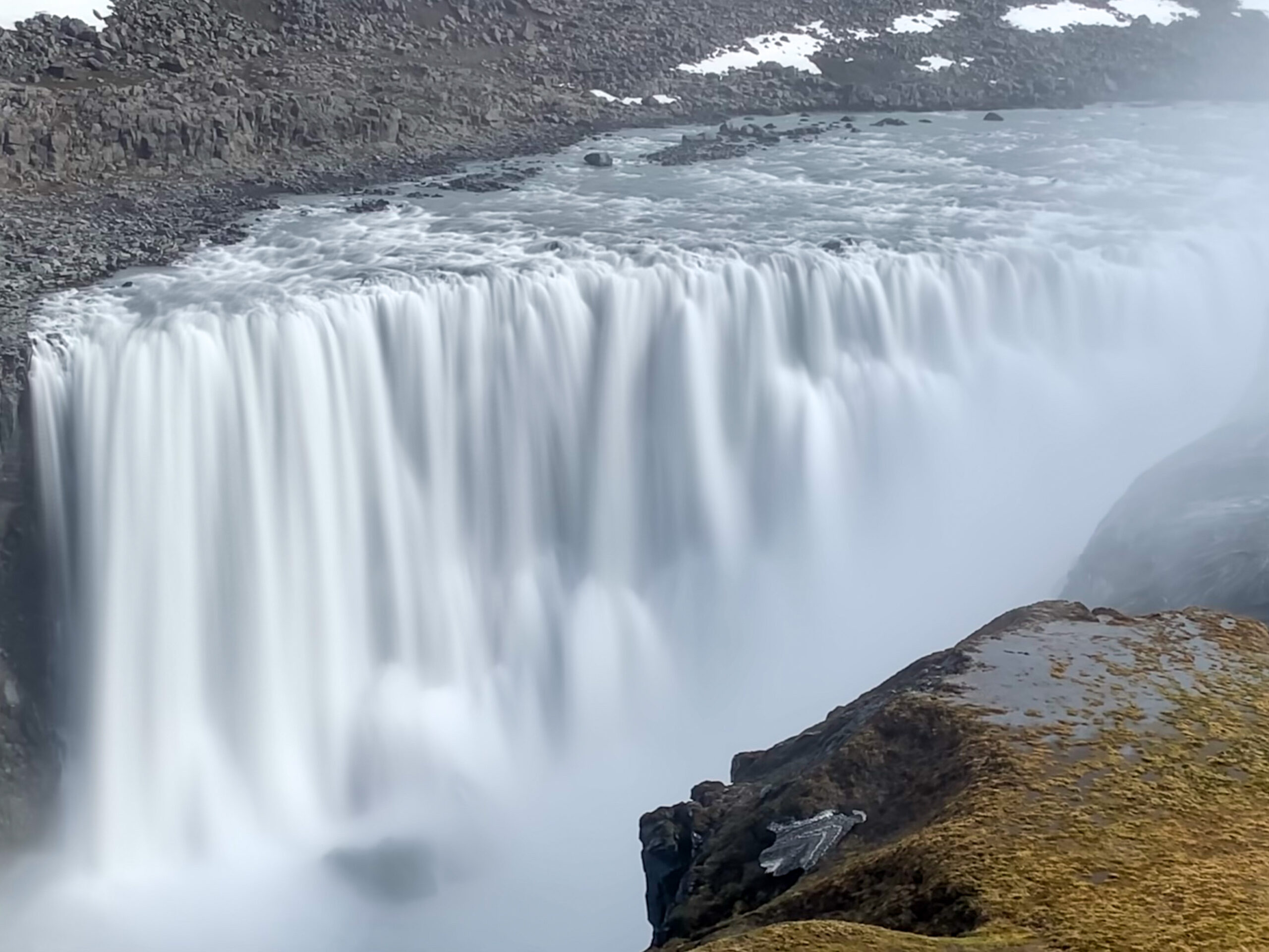
Dettifoss is situated on the Jökulsá á Fjöllum river, which flows from the Vatnajökull glacier and collects water from a large area in Northeast Iceland. This is one of Iceland’s big tourist sites and we are all impressed—even though nary a bird is seen or heard during this stop.
We have one more item on the itinerary for the afternoon—one that is a wonderland of geothermal features just off the road. Hverir, with a variety of mud cauldrons, steaming vents, radiant mineral deposits, and piping fumaroles in a lunar-like landscape. After all have their fill of paint pots, sulfur, and views of nearby cinder cones, we repair to the vehicles for the final, short hop to the hotel. Icelandair Hotel Mývatn is located in the burg of Reykjahlíð on the lake’s northeastern shore, and we get our first views of the broad, but quite shallow, body of water as we approach “town”. Mývatn is a shallow lake situated in an area of active volcanism in the north of Iceland, not far from Krafla volcano. The lake and the surrounding wetlands provide a habitat for a number of waterbirds, especially ducks. The lake was created by a large basaltic lava eruption 2300 years ago, and the surrounding landscape is dominated by volcanic landforms. The name of the lake (Icelandic mý (“midge”) and vatn (“lake”); “the lake of midges”) comes from the large numbers of midges present in the summer. The lake is unusually shallow and is fed by nutrient-rich spring water and has a high abundance of aquatic insects that form an attractive food supply for ducks. Fifteen species of duck breed at the site, the largest such number in Europe. The duck species composition is unique, with a mixture of European and North American species, and also of boreal and arctic species. The outflowing Laxá River is home to Harlequin Duck and Barrow’s Goldeneye. Most of the Barrow’s Goldeneyes overwinter there, using ice-free areas kept open by emerging spring water (both warm and cold) and in the strong river current. This species is a cavity-nester, here using holes in the lava for nesting. The other duck species nest abundantly in the numerous islands of the lake and the surrounding marshlands.
We pull into the parking lot, with views across the street to the lake (between buildings). Even this brief look reveals ducks and grebes floating on calm water.
After dinner we have plenty of light to explore, especially since it really does not get dark. A small pasture/fenced field next to the hotel offers excellent views of a number of shorebirds, including brick red Black-tailed Godwits, curved billed Whimbrels, and black and gold Plovers.
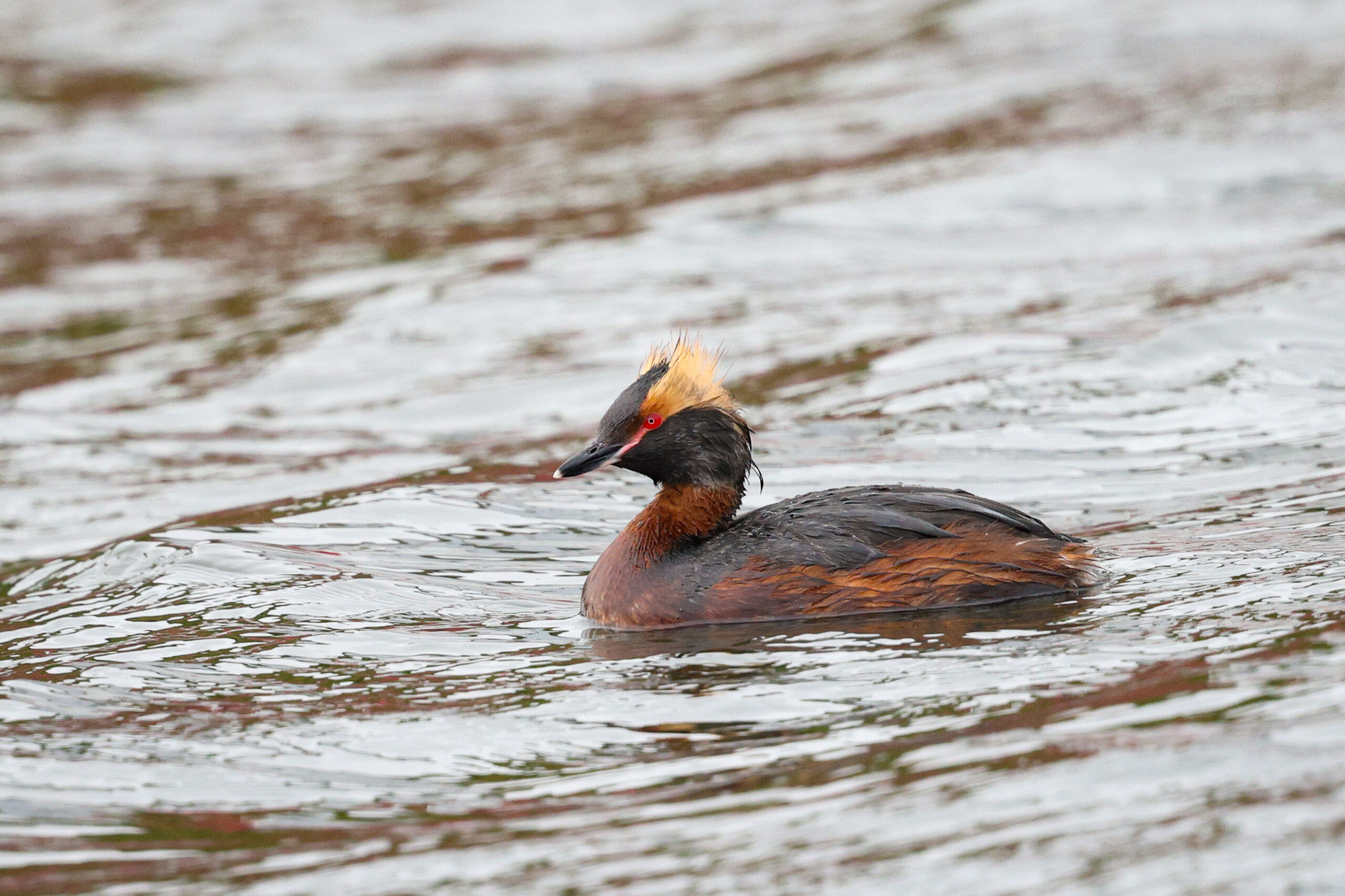
We make an exploratory run targeting the lake’s northeastern and eastern shore down to the intersection of the Ring Road and Route 848. We find a dirt road, sign announcing a bird reserve, and no traffic, perfect for stopping to scope the water. Habitat here consists of “big water” edges, shrubby grasslands, and scattered freshwater pools. Birds spotted include Long-tailed Duck, Barrow’s Goldeneye, Red-necked Grebe, and sultry breeding plumaged Horned Grebe.
We then work our way along the lake’s west shore, the road narrow with almost no shoulders so there are limited the opportunities to bird from the road. We reach the Laxá River, finding a tumbling mass of whitewater of the type preferred by Barrow’s Goldeneye and Harlequin Duck, before returning to the hotel.
Thursday, May 26 — Lake Mývatn
Today looks to be another wet day–with the added challenge of fog! Temperatures dropped into the mid-30s overnight, so we awaken to cold overcast, a stiff breeze, and fog. We start on the same marshy peninsula we visited last evening. More of the same birds entertain, including a decent number of Common Scoters. Certainly the best sighting is that of a Short-eared Owl soaring high overhead! Other fun birds include four Red-throated Loons flying by, a pair of Parasitic Jaegers hunting over the marshland, and the nearly ubiquitous Redwings.

Continuing along the lake’s western shore in the direction of the Laxá, we make a few stops, adding Common Loon to the tally, but seeing just a smattering of ducks on the lake. We stop at a few more places along the lake, adding a nice pair of Long-tailed Ducks before reaching the rushing river. It’s raining a bit now, but not enough to deter folks from walking along the river’s edge to view and photograph pairs of lovely Barrow’s Goldeneye and Harlequin Duck, along with a drake Long-tailed Duck swimming in the torrent.
Finding less access along the lake’s southern arc than hoped, we take in scenery as more and more of the pseudo craters dominate the landscape (features that look like volcanic cones but were made by huge bursting bubbles of steam). Shortly, we arrive at Dimmuborgir (dimmu “dark”, borgir “cities” or “forts”, “castles”), a large area of unusually shaped lava fields east of the lake. With some time before lunch, the group splits up to explore the trails and learn about the unique geologic and local history of the area. Not far from the Visitors Center, a few birds are spotted: mainly Redpolls and Redwings.
After getting everyone rounded up, we drive the short distance to complete our circumnavigation of the lake.
Following lunch, we head for Steve’s “surprise stop” at Viti Crater Lake. A very short walk leads from the hilltop parking area to the crater’s rim, with views of ice-clogged blue water far below. On the drive back, we stop briefly at an incongruous shower head spewing warm water. The creator of this bit of public modern art is unknown, however many post photos of the stray bathroom equipment on the net, and some are even said to make use of the constantly flowing hot water.
At this point in the afternoon we have done about as much birding as we can considering the weather, and folks may appreciate the chance to relax at the hotel during our single two-night stint at the same hostelry.
Friday, May 27 – Lake Mývatn to Skagafjorour
After another great breakfast, we load up the van and prepare for departure. Temperatures are in the 30s with overcast and mist. We don’t stop much on the way out; a combination of weather and few pull-outs dictate that we continue on past the Laxá River intersection and press westward. Our first scenery stop is the waterfall Goðafoss. These falls drop only 12 meters, but across a curved, horseshoe width of 30 meters, the sight is both pretty and powerful.
We continue on toward Akureyri, taking a fairly recently completed 7-kilometer road tunnel through the long mountain skirting the fjord on which Iceland’s second city sits. As we bore deeper into the mountain, air temperature as measured on the van’s dash rises into the mid-70s before plunging back to winter-like values as we exit to a view of saltwater.
Akureyri, population just under 20,000, sits at the head of north-south running Eyjafjörður, just 100 miles south of the Arctic Circle. And while small, this is nonetheless the largest Icelandic city folks on the tour have seen, since our trip has yet to visit Reykjavik.
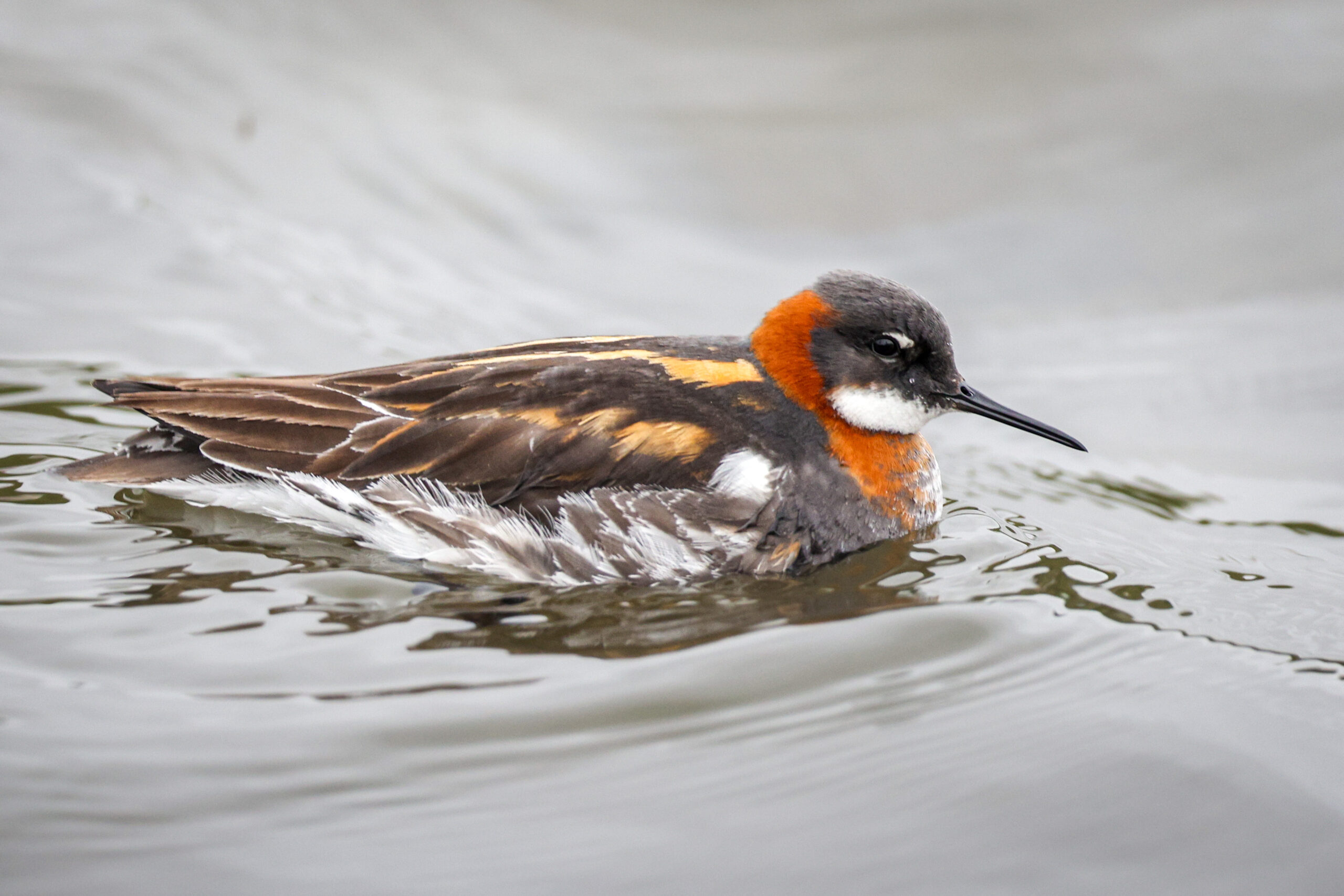
We stop at a pull-off high over the water, spotting a few birds including a Glaucous Gull and absorbing lots of scenery. The road drops to sea level where the Glerá River enters the fjord. Here a combination of marshy islands and pool of water impounded by highway causeways provide birding opportunities, and unlike during our recent travels, road shoulders are wide and plentiful. The small pond near the airport, as promised, is good for birds. Tufted Ducks float on water, Red-necked Phalaropes spin in shallows, and shorebirds pick their way along grassy strips between water and road.
The highlight was finding an amazing flock of 42 Rudy Turnstones, all in bright breeding plumage. The causeway leading across the fjord’s base produce a pair of Long-tailed Ducks and a pair of Red-throated Loons gliding in a calm, reed-fringed pool.
The group splits up and turns from birding to sightseeing in mid-morning. Akureyri is a charming compact locale with its waterfront, shops and landmark church. Akureyrarkirkja is a miniature version of Hallgrímskirkja which we will see tomorrow when we arrive in Reyjkavik. After an hour of exploring, we reunite and seek out a restaurant for lunch.
After lunch we visit the Botanical Garden in the middle of the city, a park-like setting with all of the vegetation predictably signed and beautifully arranged. Given the mature trees and shrubs, we are hopeful for a few more songbirds such as a Goldcrest or two or perhaps even a European Wren. But we only manage to find more Common Redpolls. A large flock feeding on seeds in and under some conifers provides excellent looks at these plucky, reddish little finches. Susan has a glimpse of a European Siskin but since she could not relocate it, she declines to count it for the trip.

Early afternoon finds us back on the Ring Road headed further west through more mountainous terrain. It is open and undulating as we work our way toward Skagafjorour. Bird diversity along the way is low. However, the journey is not without avian excitement: not only does a pair of Parasitic Jaegers pass close to the front of the van, Tom nearly hits two male Ptarmigan tussling on the roadway with his SUV! After we descend closer to sea level, we stop for a bit at a very scenic spot along channels of glacial outwash.
Here we find, among other things, the last flock Pink-footed Geese of the trip. The clouds are gone and the sun is now out and shining brightly. The colors of the grasses and the distant hills are stunning in the late day light.
By late afternoon, we are at the hotel. The Hotel Varmahlid lies at the crossroads of Route 75 and the Ring Road. It is charming and historic with tidy rooms. The hotel has a very nice restaurant with views of the surrounding countryside. After settling in, a few of us make a circuit of the neighborhood to stretch our legs but manage to find few birds along the way. We only “spish” up a couple more Redpolls that can be added for the day. Dinner tonight is again fresh and flavorful.
Saturday, May 28 – Skagafjorour to Reykjavik
This morning we end up getting a late start. Breakfast is not served until 8AM –but with delicious fresh breads, fruit, cheeses, eggs and smoked meats, it is worth the wait. After repacking the van and gassing up the vehicles, we are once again on the way westward– on the last leg of our circumnavigation of the island. And it is another beautiful day! Yay!!
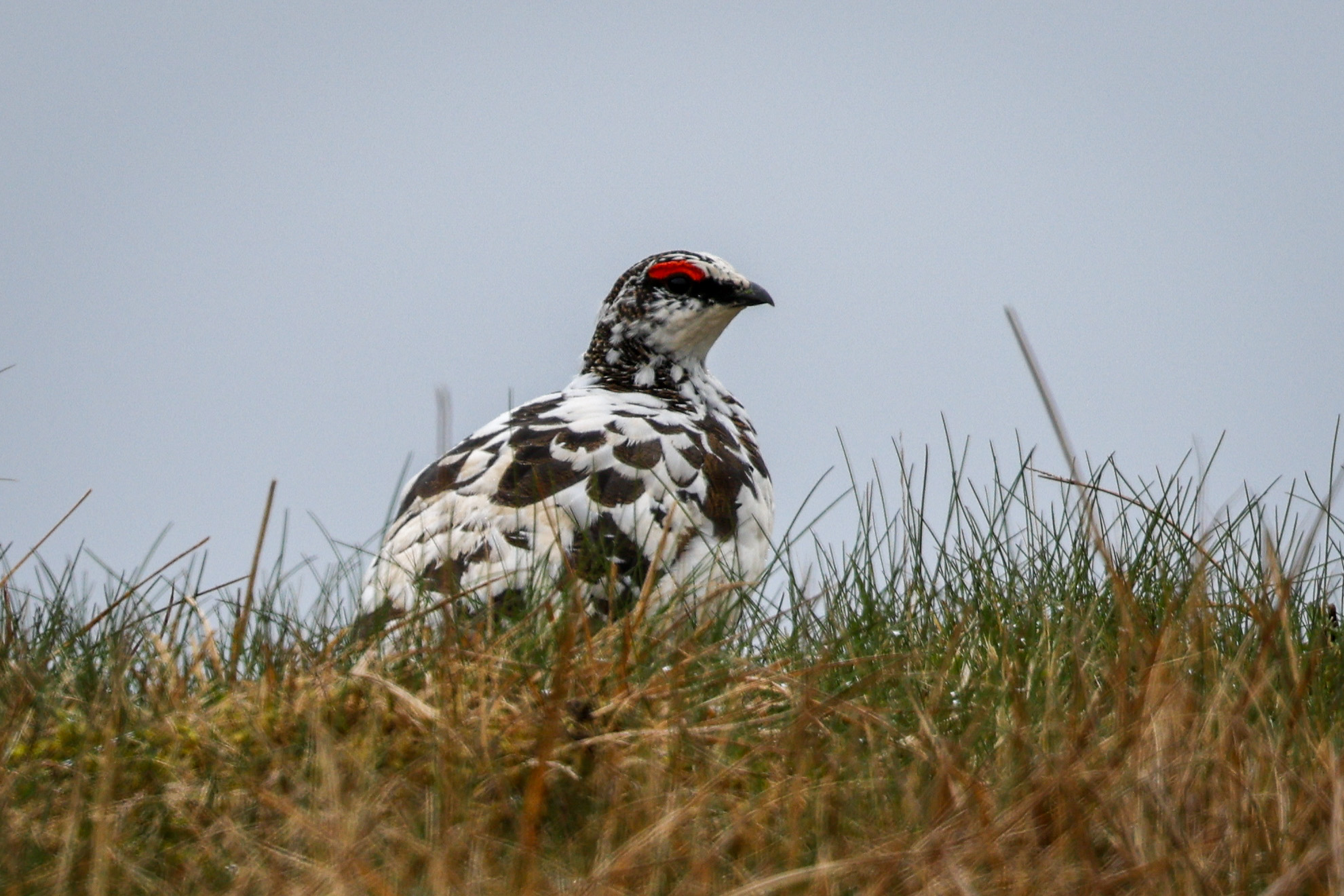
In about an hour, we climb a rise and can see the North Sea off the right side of the vehicles. This is the closest we will get to the coast but it is quite sight. The water is a deep blue in the bright sunshine. Almost immediately we happen upon a wildlife reserve right alongside the road: Hrutey Island, a nationally renowned bird sanctuary. We do not have much time so can only scope part of the river and walk along the edge of the parking area. As we pull in, we notice a male Rock Ptarmigan walking through the tall grasses, in no hurry to leave the area. And we quickly see why: his mate is on a nest in a clump of vegetation nearby– just beyond the edge of the pavement.
New families of Graylag Geese are also noticeable on the island itself which is across a small bridge not far from where we are standing. Apparently, access to the island (via the footbridge) is about to be closed for the season to protect the nesting birds.
We have to tear ourselves away and continue down and through the cute port town of Blonduos. Less than hour further along the Ring Road, we find the Grabrok crater. This pint-sized volcano provides an up close and fascinating look at a cinder cone- complete with a nice trail, stairs with handrails and interpretive signage. It is the only place where some of us manage all too brief looks at a Northern Wheatear, in addition to more of the seemingly ubiquitous Redwings.
After a quick lunch stop, it is on to Reykavik. Back at sea level we wind our way toward the Reykanes Peninsula. We can see the city from quite a distance and as traffic becomes inevitably heavier, our progress is nowhere near as speedy as it has been for the last several days. But finally the signage indicates we are in the capital. And the city’s largest landmark, Hallgrímskirkja, is on the horizon. This big Lutheran church, sporting a 244-foot spire is the tallest building in Iceland and largest church in the country.
From the church we explore the on foot, heading down the hill and around the city pond. Here we have more close-up views of Whooper Swans, Tufted Ducks, Eurasian Wigeon, Arctic Terns, Lesser Black-backed Gulls and a very cooperative Eurasian Blackbird. Leaving the birds behind, we work our way back up the main street (Laugavegur), stopping at Brava for a beer and then on to the church with a couple of us visiting inside.
Steve scores the group a dinner reservation at the iconic Loki Grill. Since we get through our Covid testing quickly (and are all negative—yay!), we arrive early and are seated immediately. This is a wonderful way to end the trip. Folks really enjoy the opportunity to sample a wide variety of Icelandic fare, although arguably we’ve done so all week. One of the most popular items on the menu is a variety plate with fish mash, smoked lamb, bread, potatoes, and a few pieces of dried cod. It also features small pieces of Iceland’s infamous fermented shark. Amazingly, several members of our group partake of the delicacy, and no one gags!
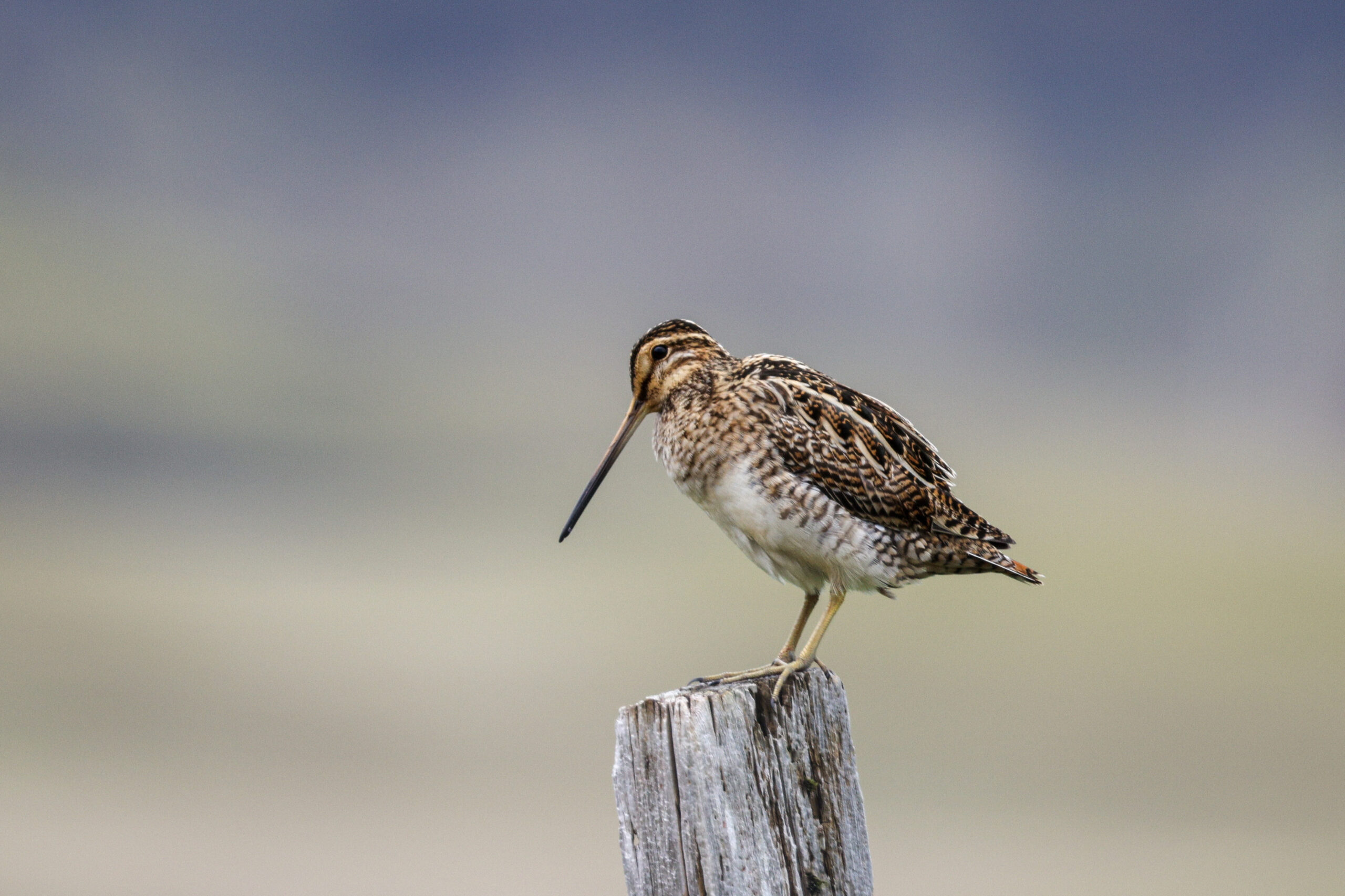
After dinner we drive to the outskirts of Reykjavik and our lodging for the night, Kruines Hotel. Kruines is tucked away, off the beaten path, on a wonderful piece of property. The hotel has been recently renovated and expanded. The rooms are beautiful and modern with expansive views of the surrounding landscape. We all instantly relax! To toast the end of our adventure, we pass around a bottle of Brennavin, Iceland’s famous liquor, as the group winds down. But there are still a few birds to enjoy out on the water behind the hotel, and even though the hour is late, we have plenty of sunlight. Common Snipe are displaying, a European Oystercatcher is foraging near the lakeshore and there is a Common Redshank making passes over our heads. A Horned Grebe on a floating nest in the little bay nearest the hotel makes everyone smile.
Sunday, May 29 – Keflavik and home
We awaken to a beautiful view out of the windows. Kruines is a stunning location and will be hard to leave. Blue lake, snow dusted mountains beyond, all under a blue sky. Most of us have just enough time for a wonderful Scandinavian breakfast buffet before heading back to the airport in Keflavik. Our bird total for the trip is 68 species. And the weather tally will end up being 4 sunny days, 2 cloudy days– and only 2 rainy days. Temperatures in the 30’s and low 40’s up north were indeed somewhat surprising. But all in all, not bad for Iceland!

